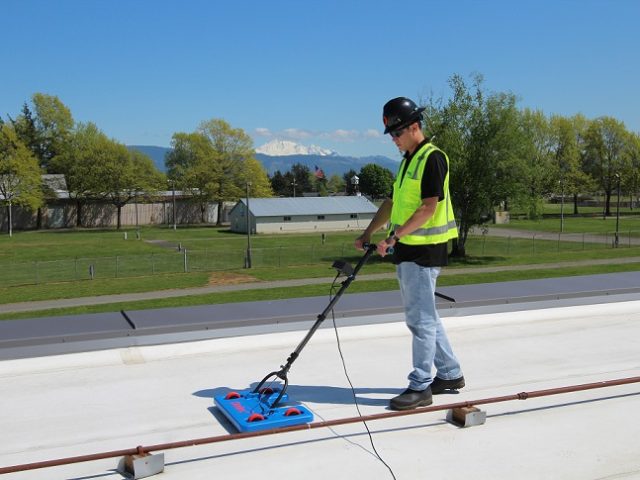Comparing IntegriScan with other leak detection methods
IntegriScan vs Other Leak Detection Methods
IntegriScan is a point in time, quality control Electronic Leak Detection testing service that confirms the integrity of the waterproofing/roofing membrane installation
- Test 100% of waterproofing/roofing membrane versus other “hunt and peck” methods
- Reliably tests vertical surfaces
- Wall junctions, perimeter details and membrane penetrations are easily tested
- Tests up to 3,715 square meters per day
- Detects hard to see breaches
- Breach repairs can be re-tested the same day
- Minimal setup time; No perimeter wire required; No need to isolate penetrations
- Audio & visual components for easy and accurate breach location alerts
- Tests conventional membranes with TruGround Conductive Primer directly under the membrane
- Only the ELD method available for testing black EPDM and other semi-conductive membranes
- Can be used for forensic testing of existing roofs
- The most advanced, accurate, reliable, and cost effect Electonic leak detection method available
- A superior alternative to flood testing
- Meets ASTM D8231-19 ( Standard practice for Electronic Leak Methods for detecting and locating leaks )
Flood Testing
- Meet Guide ASTM D 5877 for ELD Testing only. Does not meet current ASTM D8231 practice for ELD
- No large volumes of water wasted
- Speed of test. Flood testing generally takes days
- Flood testing invariably doesn’t test to the entire substrate.
- Doesn’t precisely locate defects
- Possible structural loading stress
High Voltage Testing
High voltage was developed in Europe in the 1970s. This method works on horizontals as well as verticals but does not work on semiconductive membranes such as black EPDM. The technician sweeps the metal brush over a completely dry membrane.
Any moisture present will create a false alarm. The equipment releases up to 40,000 volts, and when it passes over a breach, a spark will be seen. High Voltage is not the best for seam void detection as it requires a direct vertical air gap to spark. The spark will not travel horizontally.
It also relies on the technician to calibrate the electronics for the micron thickness being tested. If the electronics are set too low, breaches will be missed. If calibrated too high, it can burn the membrane.
- Meet Guide ASTM D 5877 for ELD Testing only. Does not meet current ASTM D8231practice for ELD.
- Must be calibrated for membrane thickness. May cause damage or miss leaks if membrane thickness varies as with Liquid systems.
- Must be performed in perfectly dry conditions
- Cannot test semi-conductive membranes such as black EDPM or Butynol
- Struggles to pick up seam breaches in sheet membranes
High Voltage Testing
- Vector Mapping is a triangulation-based sampling technology developed in Germany in the early 1970’s. This method was originally created for testing pond liners and was then adapted for the roofing/waterproofing industry.
- A perimeter wire is installed to define an isolation area and then probing poles are used to sample the area within the isolation area. The results rely heavily on the technician’s experience and amount of water utilized.
- Testing can only be performed within the areas isolated by the perimeter wire. Vector mapping CAN NOT test transitions and details, and can not reliably test verticals.
- YES, within the perimeter wire isolation area.
- In new construction, vector mapping will work with a conductive medium placed directly under the membrane on conventional assemblies. Note – the vector mapping grid (aka VMG) is often not approved for proper placement directly below the membrane. Placement below the coverboard or insulation blocks the electrical path resulting in an invalid/inconclusive test.
- NO – Vector mapping can only test non conductive membranes.
- Vector mapping is not feasible for testing vertical surfaces, and is not something supported by all vector mapping equipment manufacturers or testing agencies.
- Vector mapping may be able to test up to 20,000 sq ft/day. This method requires set up prior to testing. Set up time varies depending on the square footage, number of areas to test, and the number of penetrations.
- Vector Mapping has a high potential for false positives and complete misses. Breaches close in proximity can get missed. Wall junctions, perimeter details, and membrane penetrations can only be visually inspected.
- Vector Mapping is not an FM approved testing method
Source: Official Website detecaustralia.com.au

